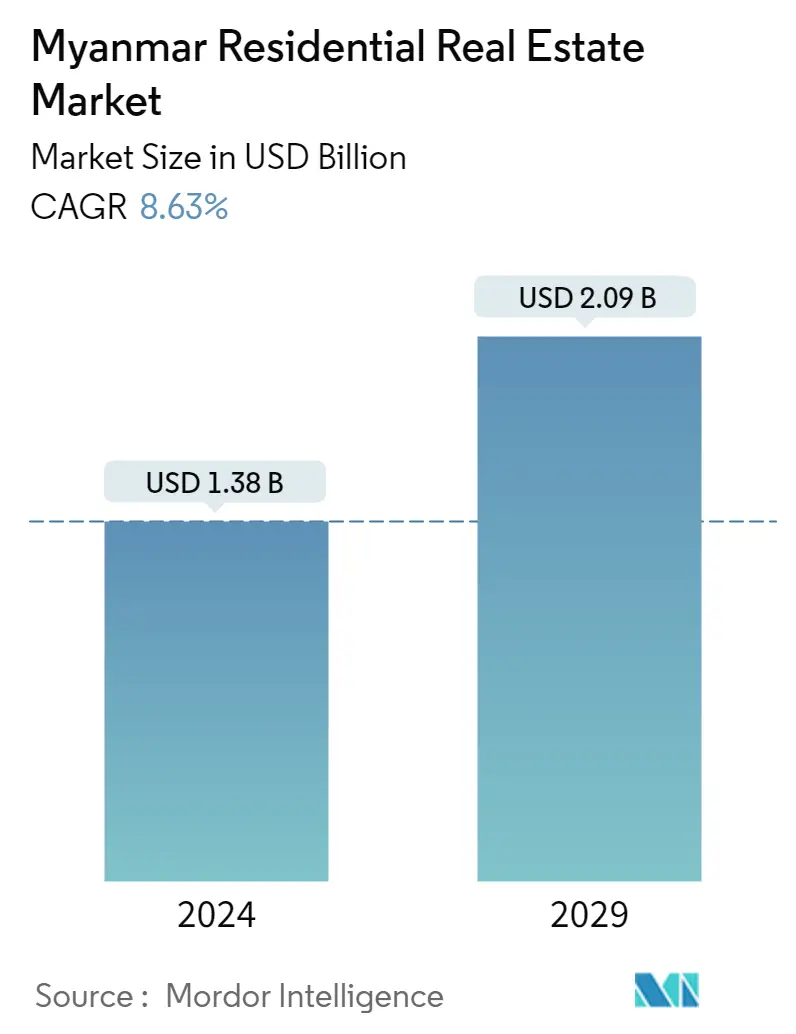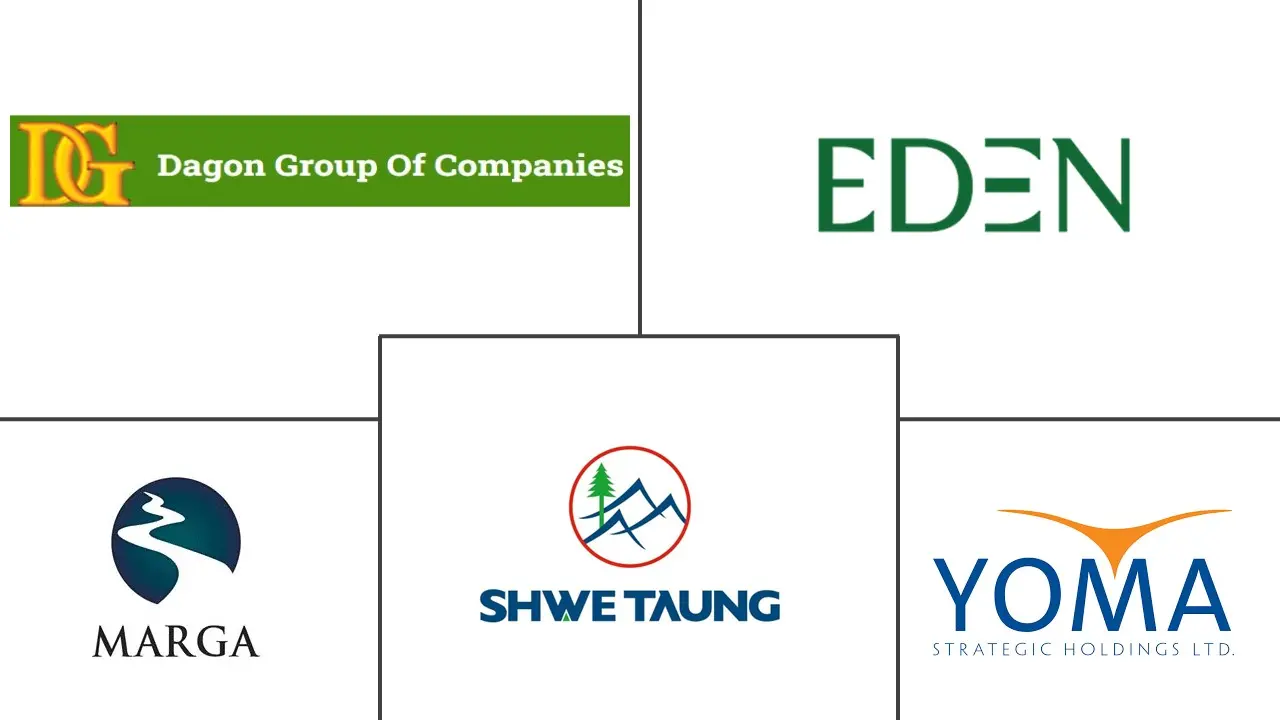Market Size of Myanmar Residential Real Estate Industry

| Study Period | 2020 - 2029 |
| Base Year For Estimation | 2023 |
| Market Size (2024) | USD 1.38 Billion |
| Market Size (2029) | USD 2.09 Billion |
| CAGR (2024 - 2029) | 8.63 % |
| Market Concentration | Low |
Major Players
*Disclaimer: Major Players sorted in no particular order |
Myanmar Residential Real Estate Market Analysis
The Myanmar Residential Real Estate Market size is estimated at USD 1.38 billion in 2024, and is expected to reach USD 2.09 billion by 2029, growing at a CAGR of 8.63% during the forecast period (2024-2029).
- The ongoing political turmoil and a rapidly rising third wave of COVID-19 cases severely impacted the Myanmar economy, which had already been weakened by the pandemic in 2020. Reduced mobility and incomes, protests, labor shortages, the ongoing disruption of critical business services, including logistics and telecommunications, and public services such as health and education have hit economic activity.
- Apartments and land parcels are always available for purchase. Year over year, the price hikes are gradual. The cost has not changed. As a result, the investors can only earn minimally. With time, both the dollar value and the price of gold are skyrocketing. Based on their purchase price, the buyers may perceive the profits. Making money quickly for housing is challenging. Because of this, many do not choose to invest in the real estate industry.
- With supposedly abolished epidemic restrictions, Myanmar is again accessible to foreign investment. Unfortunately, no one was waiting to purchase real estate in Yangon, which was bad news for local developers and stakeholders. As demand outstripped supply at the beginning of the previous decade, property values in Myanmar's former capital surged.
- The market is witnessing a rise in mixed-use developments that combine residential, commercial, and retail spaces. These developments offer convenience and a live-work-play lifestyle, attracting buyers and investors seeking integrated communities.
Myanmar Residential Real Estate Industry Segmentation
Real estate (land and any buildings on it) used for residential purposes is commonly referred to as residential real estate; single-family dwellings are the most prevalent type of residential real estate. A complete background analysis of the Myanmar Residential Real Estate Market, including the assessment of the economy and contribution of sectors in the economy, market overview, market size estimation for key segments, and emerging trends in the market segments, market dynamics, and geographical trends, and COVID-19 impact is included in the report.
The Myanmar residential real estate market is segmented by type (villas/landed houses and condominiums/apartments) and by cities (Yangon, Mandalay, Naypyidaw, Mawlamyine, and Other Cities). The report offers market size and forecasts in values (USD) for all the above segments.
| By Type | |
| Villas/Landed Houses | |
| Condominiums/Apartments |
| By Cities | |
| Yangon | |
| Mandalay | |
| Naypyidaw | |
| Mawlamyine | |
| Other Cities |
Myanmar Residential Real Estate Market Size Summary
The Myanmar residential real estate market is navigating a complex landscape shaped by political instability and the lingering effects of the COVID-19 pandemic. Despite these challenges, the market is poised for growth, driven by a resurgence in foreign investment and the development of mixed-use projects that integrate residential, commercial, and retail spaces. These developments are designed to offer a convenient lifestyle, appealing to buyers and investors seeking cohesive communities. However, the market remains fragmented, with numerous players such as Marga Group, Shwe Taung Group, and Yoma Strategic Holdings actively participating. The ongoing political and economic challenges have led to a gradual increase in property prices, but the market is experiencing slow growth due to a mismatch between supply and demand, which has exerted downward pressure on prices.
Efforts to improve the socio-economic conditions in urban areas are underway, with government initiatives like public rental housing projects in major cities such as Yangon, Mandalay, and Nay Pyi Taw. These projects aim to provide affordable housing and stimulate economic activity through construction. The market is also witnessing innovative strategies to address urban poverty and enhance resilience in low-income communities, supported by international organizations and local partnerships. Despite the slow recovery and ongoing challenges, the market is absorbing new projects, and there is potential for modern housing seekers to invest, albeit cautiously, in the evolving real estate landscape of Myanmar.
Myanmar Residential Real Estate Market Size - Table of Contents
-
1. MARKET DYNAMICS AND INSIGHTS
-
1.1 Market Overview
-
1.2 Market Dynamics
-
1.2.1 Market Drivers
-
1.2.1.1 The growing concept of integrated living
-
1.2.1.2 Increasing the construction of residential spaces such as single-family homes, condos, cooperatives, duplexes, townhouses, and multifamily residences in the country.
-
-
1.2.2 Market Restraints
-
1.2.2.1 Regulatory uncertainty
-
-
1.2.3 Market Opportunities
-
1.2.3.1 Technology adoption in the real estate sector
-
-
-
1.3 Value Chain/Supply Chain Analysis
-
1.4 Industry Attractiveness - Porter's Five Forces Analysis
-
1.4.1 Bargaining Power of Suppliers
-
1.4.2 Bargaining Power of Buyers/Consumers
-
1.4.3 Threat of New Entrants
-
1.4.4 Threat of Substitue Products
-
1.4.5 Intensity of Competitive Rivalry
-
-
1.5 Residential Real Estate Buying Trends - Socioeconomic and Demogpaphic Insights
-
1.6 Government Initatives and Regulations in Residential Real Estate Sector
-
1.7 Insights on Size of Real Estate Lending and Loan to Value Trends
-
1.8 Insights on Interest Rate Regime for General Economy, and Real Estate Lending
-
1.9 Insights on Rental Yields in Residential Real Estate Segment
-
1.10 Insights on Captial Market Penetration and REIT Presence in Residential Real Estate
-
1.11 Insights on Affordable Housing Support Provided by Government and Public-private Partnerships
-
1.12 Impact of COVID - 19 on the Market
-
-
2. MARKET SEGMENTATION
-
2.1 By Type
-
2.1.1 Villas/Landed Houses
-
2.1.2 Condominiums/Apartments
-
-
2.2 By Cities
-
2.2.1 Yangon
-
2.2.2 Mandalay
-
2.2.3 Naypyidaw
-
2.2.4 Mawlamyine
-
2.2.5 Other Cities
-
-
Myanmar Residential Real Estate Market Size FAQs
How big is the Myanmar Residential Real Estate Market?
The Myanmar Residential Real Estate Market size is expected to reach USD 1.38 billion in 2024 and grow at a CAGR of 8.63% to reach USD 2.09 billion by 2029.
What is the current Myanmar Residential Real Estate Market size?
In 2024, the Myanmar Residential Real Estate Market size is expected to reach USD 1.38 billion.

